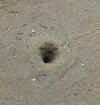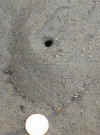Clams And Other Burrowing
Animals
Clams, shrimp, and worms hide in the wetter parts of Windy Cove. All you see
are the holes they make.
Being buried also helps keep them from being moved by the tides, when they
don't want to be.
They get food and air (oxygen), and get rid of pee and poop, through the
holes. When the holes get mashed the animal must make a new one, or die!
Do them a favor! Most of the time walk on the dry part of the beach, closer
to shore. There aren't any holes in that part of the Cove, and you'll keep your
shoes cleaner, too.

Annotated Image
for Internet Explorer users
|
Mudflat
cutaway. From: Morro Bay State Park Museum of Natural History,
Dioramas 1962-2001, by Marion Enfield and Carol Medine. |

|
Inlet Hole (Clams, some worms, certain
shrimp)
A flared, large-bore opening with small hillock. The sand is golden. Several hot-dog shaped fecal pellets lie nearby. |
 |
Outlet Hole
When sand is being expelled Underwater, this looks like a Volcano erupting. The last Eruption occurred after the Tide had receded, washing The side of the mound away.
A constricted, small opening with large hillock. The sand is gray. The fecal pellets lie further from the opening. The opening is smaller to increase velocity, like the choke on a shotgun. Notice the one-eigth-inch gravel lying about. The higher the speed, the larger the particle that can Be expelled. |
 |
Bent-Nosed Clam Shell
Macoma balthica
These are common at the Cove in winter. |
| |
Little Neck Clam |
| |
Gaper Clam |
| |
Washington Clam |
windy-cove home
Revised Monday, February 18, 2008 02:25:45 PM


